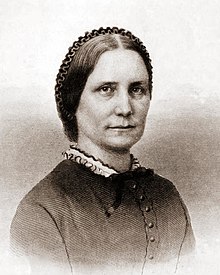
Back ماري ليفرمور Arabic مارى ليفرمور ARZ মেরি লিভারমোর Bengali/Bangla Mary Livermore Catalan Mary Livermore German Mary Livermore Spanish Mary Livermore Basque Mary Livermore French മേരി ലിവർമോർ Malayalam Mary Livermore Portuguese
Mary Livermore | |
|---|---|
 Livermore in 1867 | |
| Born | Mary Ashton Rice December 19, 1820 Boston, Massachusetts, U.S. |
| Died | May 23, 1905 (aged 84) Melrose, Massachusetts |
| Occupation | Journalist, abolitionist, women's rights advocate |
| Notable works | My Story of the War |
| Spouse |
Daniel P. Livermore (m. 1845) |
| Relatives | Mary Livermore Barrows (granddaughter)[1] |

Mary Ashton Livermore (née Rice; December 19, 1820 – May 23, 1905) was an American journalist, abolitionist, and advocate of women's rights. Her printed volumes included: Thirty Years Too Late, first published in 1847 as a prize temperance tale, and republished in 1878; Pen Pictures; or, Sketches from Domestic Life; What Shall We Do with Our Daughters? Superfluous Women, and Other Lectures; and My Story of the War. A Woman's Narrative of Four Years' Personal Experience as Nurse in the Union Army, and in Relief Work at Home, in Hospitals, Camps and at the Front during the War of the Rebellion. She wrote a sketch of the sculptor Anne Whitney for Women of the Day and delivered the historical address for the Centennial Celebration of the First Settlement of the Northwestern States in Marietta, Ohio on July 15, 1788.[2]
When the American Civil War broke out, Livermore became connected with the United States Sanitary Commission, headquarters at Chicago and performed a vast amount of labor of all kinds by organizing auxiliary societies, visiting hospitals and military posts, contributing to the press, answering correspondence, and other things incident to the work done by that institution. She was one of those that helped organize the great fair in 1863, at Chicago, when nearly $100,000 was raised and for which she obtained the original draft of the Emancipation Proclamation from President Lincoln, which was sold for $3,000, and funded the building of the Soldiers' Home.[2]
When the war was over, she instituted a pro-women's suffrage paper called the Agitator, which was afterwards merged in the Woman's Journal. Of that she was an editor for two years and a frequent contributor thereafter. On the lecture platform, she had a remarkable career, speaking mostly on behalf of women's suffrage and temperance movements. For many years, she traveled 25,000 miles (40,000 km) annually and spoke five nights each week for five months of the year.[2]
© MMXXIII Rich X Search. We shall prevail. All rights reserved. Rich X Search